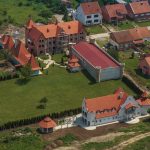January 13, 2020 – New facilities such as theme parks and trails, rest areas, lookouts, cultural and artistic checkpoints, ecological-educational trails and specialized training grounds and structures for sports and recreational activities will soon be developed in Lim Bay.
Glas Istre writes that at the beginning of this year, the Istria County Administrative Department of Tourism will announce a public call for co-financing events and tourism projects in Istria, for which HRK 660,000 is foreseen.
Events that prolong the tourist season and direct tourist flows to less developed areas of Istria are encouraged. County Head for Tourism Nada Prodan Mrakovic points out that through local manifestations and tourism projects they want to strongly promote the local traditions and customs and the valorisation and presentation of typical Istrian products, but also emphasize environmental protection and all other environmental aspects.
“Through the program of promoting the sustainability and quality of tourist events in Istria, we strive to motivate the organizers for the sustainable development of events, but also for the organization in the pre and post-season and in less developed tourist areas, which raises the level of attractiveness of the destination and provides additional content,” says Prodan Mrakovic presenting this year’s plan of work by the County Department of Tourism.
They are focused on developing Istria as a quality tourist destination oriented to year-round tourism and sustainable development, which drives the local economy and strengthens local values, customs and traditions, respecting space and architecture, protecting heritage and preserving and smartly valorizing natural and cultural resources.
“This requires the consensus of all tourism stakeholders in Istria, responsibility and smart development. The basis of our programs is the Master Plan for Tourism of Istria from 2015 to 2025, from which I highlight several important measures of the operational strategy that we guide in our activities. These include aligning the development of accommodation types with product development, the database of private accommodation and the new marketing process according to accommodation types. We encourage the Touring System of Istria, that is, we support initiatives of cities and municipalities and their tourist boards to organize lookout points, rest areas and info-points precisely to develop this segment more and to enable guests to get to know more about the beauties and contents throughout Istria. This is complemented by the Visitor Interpretation System, where some are already in operation, such as Mare the Witch’s House in Svetvinčenat, the Visitor Center in Barban, the Arsia Center in Raša, and several are still in the works. At the same time, many are still being prepared,” says Prodan Mrakovic.
With the “Istria Culture” measure, the goal is to use cultural resources to enhance tourist attractiveness and further diversify experiences and attract more visitors motivated primarily by culture.
“We started measuring some indicators of Istria’s sustainable development according to ETIS, the European System of Sustainability Indicators for the Development of Tourist Destinations, and CROST, the Observatory for Sustainable Tourism Development in Croatia, a project of the Institute of Tourism launched to measure and monitor the sustainability of tourism in Croatia. In doing so, we want to sensitize the public to the importance of sustainable tourism development and raise awareness and to make plans and policies for future development based on the indicators obtained. What will help us even more with this is the Sustainable Tourism Study, which is being produced at the Institute of Agriculture and Tourism in Porec, which should give us answers about the perceptions of the population and local self-government units in Istria on sustainable development, the plans they have for the future and the like,” she added.
In the segment of private accommodation, this is followed by the continuation of the development and promotion of the EcoDomus project (eco-friendly accommodation), for which the budget of the Tourism Department is planned at HRK 180,000. The project was awarded at this year’s Croatian Tourism Days and was awarded the HTZ Award in the Sustainable Tourism Development category. So far, more than 40 private renters from all over Istria have been awarded the EcoDomus certificate, which is encouraged to tailor their facilities and services to guests responsibly and sustainably. The criteria for obtaining a certificate are valued local values. The host is also encouraged to inform guests about the local cultural and historical heritage, natural values, amenities and events, arrange the environment of their facility with native plant species, promote traditional products and souvenirs, inform guests about learning opportunities and/or participating in traditional customs, promotee local cuisine and typical food products, save water and electricity, sort waste, use environmentally friendly cleaning products and the like.
“Regarding the tourist infrastructure, we continue to maintain and promote the Parenzana hiking and cycling trail, in synergy with the towns and municipalities through the route, namely Poreč, Višnjan, Kaštelir, Vižinada, Karojba, Motovun, Oprtalj, Grožnjan, Buje and Umag. In order to ensure the conditions for continuous and undisturbed sports and recreational use of the route, regular maintenance is necessary. Considering the limited possibilities of local budgets, especially the smaller units of local self-government in the interior of Istria, by pooling earmarked funds of HRK 300,000 for arranging and maintaining Parenzana, a systematic solution is ensured throughout the calendar year,” points out Prodan Mraković.
The County Tourism Department is continuously investing HRK 260,000 annually in Parenzana, independently and from its resources, and this year will set up signposts, boards for various purposes, illuminated tunnels, and enable Internet connection in some places, all to increase its attractiveness, because it is traversed by around 100,000 cyclists and pedestrians every year. This project valorises untapped resources and fosters an economically and socially sustainable environment, such as cycling services, catering (from private accommodation to boutique hotels, taverns and agritourism), wine cellars, olive oil roads, medieval towns and the like.
“In recent years, we have witnessed increased activities around the beaches, which are also supported by the Ministry of Tourism. In this segment, it is very important to manage beaches smartly and responsibly, since beaches are the most important natural resource in the product of the sun and the sea, which is dominant in Istria. Developing the document of the regional program for the development and management of beaches created the preconditions for improving the quality of all the beach content by thematizing the beaches and prescribing the minimum technical conditions of development, the long-term sustainability of managing these areas, as well as improving the attractiveness and visual identity of the entire coastal zone of Istria. This is a prerequisite for an increased satisfaction of tourists and locals through the use of those beaches that are thematically best suited to their interests and preferences,” says Prodan Mrakovic.
Three-Hundred-fifty-thousand kuna has been earmarked this year to encourage the development of selective forms of tourism, such as cultural and sport-recreational tourism, and especially cycling tourism. This includes support for IRTA’s Istra Inspirit program, which is based on the valorisation of Istrian myths and legends and their attractive approach to guests. The main objective of the project is to enrich the tourist offer through the segment of cultural and historical heritage and create a unique experience and stories and indirectly extend the tourist season and enrich the cultural and tourist offer. Together with private individuals and others in the public sector, it supports the development of cycling tourism and other nature-based activities throughout Istria, in collaboration with the Istria Bike department established within IRTA.
“In order to investigate the cycling situation on the Istrian market and the satisfaction of locals and tourists with cycling, we have conducted a study on managing the quality of development of cycling tourism in Istria County. The study aims to investigate users’ opinions regarding the expected quality and satisfaction of tourists and visitors with the current offer of cycle tourism products in the destination. The main objective of the Study is to offer a sustainable model of quality management for the cycling tourism product. Implemented activities will include examining the opinions and attitudes of cycling tourism service providers and defining indicators that will be able to continuously monitor the quality of cycling tourism at the county level. The project is co-financed by the Ministry of Tourism, and the study costs HRK 187,500, according to Prodan Mrakovic.
In the natural heritage segment, the Gulf of Lim and the Lim fjord is a space that needs to be smartly and responsibly developed to enhance its attractiveness, but not to the detriment of nature, plants and animals living there. Therefore, based on the “Spatial and Programming Basis of the Gulf of Lim and Lim Fjord”, adopted by the Assembly of Istria County, together with the Public Institution Natur Histrica and the municipalities and cities that fall within the scope of the professional foundation, the natural and cultural heritage will be valorized. In accordance with the expert background, existing activities will be upgraded and new facilities such as theme parks and trails, rest areas, lookouts, cultural and artistic checkpoints, ecological-educational trails and specialized training grounds and structures for sports and recreational activities will be developed. The realization of individual segments from the expert background is planned to be financed from EU funds, since it is harmonized with the European directives and spatial planning documentation of the County of Istria.
“We will continue to be present in the education segment of existing and potential caterers. The training aims to raise awareness of the importance of nurturing table culture and authenticity, as well as professionalizing and investing in quality with all catering providers, through incorporating acquired knowledge and skills into the tourist offer of the facility. To sum it up, our goal is to raise awareness of responsible and sustainable tourism development, which implies controlled and quality development based on plans and concepts, long-term perspective, local community involvement, local employees and respect for native architecture. Tourism must promote and enhance economic viability, social balance and environmental friendliness. Therefore, it is important for us to strengthen the local economy, preserve and promote local values, customs and traditions, and preserve the environment and local architecture,” concluded Mrakovic.
To read more about travel in Croatia, follow TCN’s dedicated page.







